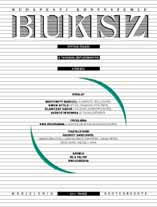
Utak és tévutak az ökofilozófiához
Review of: Lányi András: Az ember fáj a földnek, Utak az ökofilozófiához, L’Harmattan, Budapest, 2010. 209 oldal, 2200 Ft
More...We kindly inform you that, as long as the subject affiliation of our 300.000+ articles is in progress, you might get unsufficient or no results on your third level or second level search. In this case, please broaden your search criteria.

Review of: Lányi András: Az ember fáj a földnek, Utak az ökofilozófiához, L’Harmattan, Budapest, 2010. 209 oldal, 2200 Ft
More...
Reviews of: Horváth Sándor: Kádár gyermekei Ifjúsági lázadás a hatvanas években, Nyitott Könyvműhely, Budapest, 2009. 288 oldal, 3980 Ft Havasréti József: Széteső dichotómiák Színterek és diskurzusok a magyar neoavantgárdban, Gondolat – Artpool, PPTE Kommunikáció- és Médiatudományi Tanszék, Budapest, 2009., 255 oldal, 2590 Ft Nem kacsák vagyunk egy tavon, hanem hajók a tengeren, Független művészeti helyek Budapesten 1989–2009 Szerk. Kálmán Rita, Katarina Šević Impex – Kortárs Művészeti Szolgáltató Alapítvány, Budapest, 2010., 128 oldal
More...
Becskereki Ida: Borbély Gábor: Civakodó angyalok Bevezetés a középkori filozófiába ..... 77 Szabó Dániel: Anatol Schmied-Kowarzik: Unteilbar und untrennbar? Die Verhandlungen zwischen Cisleithanien und Ungarn zum gescheiterten Wirtschaftsausgleich 1897 ..... 81 Szakál Gyula: Takács Tibor: Döntéshozók Városi elit és városi önkormányzat Nyíregyházán a XX. század első felében ..... 83 Juhász Pál: Változó migráció, változó környezet szerk. Hárs Ágnes, Tóth Judit ..... 87 Balázs-Hajdu Péter – Szilasi László: A sas és az apró madarak Maczelka Csaba Balassi Bálint költői nyelvének utóélete a XVII. század első harmadában ..... 90 Reményi Édua: Nicholas A. Christakis – James H. Fowler: Kapcsolatok hálójában Mire képesek a közösségi hálózatok és hogyan alakítják sorsunkat? David McCandless: Az információ gyönyörű Infografika ..... 93
More...
Fontos könyvek – a BUKSZ bibliográfiája 2010. IV. negyedév
More...
Review of: Ritoók Zsigmond: Vágy, költészet, megismerés Válogatott tanulmányok, Szerk. Ferenczi Attila, Kozák Dániel és Tamás Ábel, Osiris, Budapest, 2009. 423 oldal, 3980 Ft
More...
Review of: Horváth Imre – Thomka Beáta (vál. és szerk.): Narratív teológia, Kijárat Kiadó, Budapest, 2010. 306 oldal, 2900 Ft (Narratívák 9.)
More...
Plus, Belarus blocks access to a lifestyle website, and fears grow about press freedom in Croatia after journalist’s dismissal. Around the Bloc is TOL's daily digest of the important, the trivial, the tragic, the weird, and the sober from its coverage region.
More...

When a government minister says accepting 1,853 migrants could destroy his country, it’s Europe’s hard-won freedoms that are really under attack.
More...
Plus, Tajikistan moves to silence renegade special forces commander, and the UN blasts Hungary’s anti-immigrant billboards. Around the Bloc is TOL's daily digest of the important, the trivial, the tragic, the weird, and the sober from its coverage region.
More...
When it comes to real-world problem-solving, Romania’s private schools leave their public counterparts behind.
More...
Plus, a human rights watchdog warns that Dagestan authorities are targeting a Muslim group, and a Russian group targeted by ‘foreign agent’ law is closing. Around the Bloc is TOL's daily digest of the important, the trivial, the tragic, the weird, and the sober from its coverage region.
More...
Plus, conflicting views of the Srebrenica massacre divide Belgrade and Sarajevo, and the Chinese yuan exerts an ever-stronger pull on Russian business. Around the Bloc is TOL's daily digest of the important, the trivial, the tragic, the weird, and the sober from its coverage region.
More...
Plus, four Tajikistani border guards released after months as Taliban hostages, and Kazakhstan nears the finish of a WTO membership marathon. Around the Bloc is TOL's daily digest of the important, the trivial, the tragic, the weird, and the sober from its coverage region.
More...
For over two decades a wave of public sector management reforms has swept through developed, transitional and developing countries. The role and institutional character of the state and of the public sector have been under pressure to be more market-oriented and private sector-oriented, initially in developed countries and later in some developing countries. The article concentrates on New public management (NPM). The authors give a theoretical description and key components of New public management, human resources management influenced by NPM. As underlying and fundamental aim of the new public management reform program is to transform management of public organizations into a business-like management. NPM incorporates the importation of private sector management systems and techniques into the public services. Seeking for the effectiveness of public institution’s activity the importance of human resources becomes especially evident, because it is not only the most important resource of public organizations, but also the most sensitive field, therefore when managing it, it is necessary to invoke modern prime methods and refer to the new human resource management scientific research results. The main change trends of the HR system management in the public sector should be the following ones: · The expansion of the employee development possibilities. The quality of the state institutions depends on the knowledge and qualifications of employees and the ability to use them. · The stimulation of the workers independence and creativity. The greater freedom of activity should be given to the civil servants encouraging their unconventional behavior. · The stimulation of good results and competitiveness. The greater orientation of workers to the final goal but not to the rules and procedures. The competitiveness enables to render the services of a better quality. · The development and expansion of collaboration, communication and information exchange. · The participating management style. The paper is divided into three parts. The first part examines the conception of New public management. Human resources management in public sector is introduced in the second part. The research on the ability to adapt the main NPM principles at Lithuania’s municipalities is presented in the third part.
More...
The preconditions of knowledge economy have influenced global changes, which, consequently, had an impact on the nature of organizational equity. Furthermore, a dynamic and competitive climate urges managers to perfect their skills in global orientation, strategic flexibility and quick response to changes as a prerequisite of working under ever-transforming conditions, where an organization should be in the state of continuous development, responding to new technologies, new markets, new businesses, and new people (employees and consumers). The above-mentioned business environment and information access alternate the nature of market competition as well as determine particular information demand. Quick response and flexibility could be achieved, only if decisions are based on timely and adequate information, knowledge and experience in managing the external business environment and internal capacities of an organization. Thus, the new measurement tools are in demand, which should assist in measuring, planning, evaluating and managing the value-creating process inside the organization. The role of modern management accounting systems has extended from data accumulation to strategy implementation. The most popular management accounting conceptions, namely, activity based costing (management) and balanced scorecard, disclose how changed management accounting role integrates a focus on three key stakeholder groups: employees, customers and shareholders. Built on previous management accounting studies this article explores Lithuanian experience implementing modern costing and performance measurement systems. In order to point out the changing role of management accounting in Lithuanian organizations an empirical research was performed. This research consists of two main stages. 1) Implementation level of modern management accounting conceptions and the availability of information for decision making were analyzed using quantitative data (survey). 2) A deeper analysis was performed in Lithuanian organization disclosing the changing role of management accounting after implementation of modern costing and performance measurement system (case study). Results of empirical research indicate that there is quite a strong correlation between implementation level of conceptions (ABCM and / or BSC) and a range of management areas where information generated with the help of those conceptions is useful. Case study organization has started integration stages and has created information basis for cross functional and vertical communication through different management levels, but meanwhile there is an absence of communicative relations between top and lower management levels. The results of the research disclosed that modern management accounting conceptions might be precondition for changing role of management accounting but it depends on implementation level and organization’s ability to manage all capacities
More...
This paper draws on prior research on human resource training evaluation, including its models, criteria, tangible and intangible benefits of training and return on investment. Human resource management (HRM) is the recognition of the importance of an organization’s workforce as vital human resources contributing to the goals of the organization, and the utilization of several functions and activities to ensure that they are used effectively and fairly for the benefit of the individual, the organization, and society. Today human resource management has a unique and timely opportunity to improve productivity. Increasingly, however, improving productivity does not mean just increasing output. In addition, evaluation ensures that programs are accountable and are meeting the particular needs of employees in a cost-effective manner. This is especially important today, as organizations attempt to cut costs and improve quality in their firms. Without evaluation, it is very difficult to show that training was the reason for any improvements. Human resource training may safeguard productivity as well as supporting it, insulating firms from skills shortages by preparing employees for current and future jobs. Evaluation involves identifying the appropriate outcomes to measure. The outcomes used in evaluating training programs include trainees’ satisfaction with the training program, learning of knowledge or skills, use of knowledge and skills on the job, and results such as sales, productivity, or accident prevention. Evaluation may also involve comparing the costs of training to the benefits received (return on investment). Outcomes used in training evaluation help to determine the degree to which the program resulted in both learning and transfer of training. Training evaluation provides a way to understand the investments that training produces and provides information needed to improve training. If the company receives an inadequate return on ist investment in training, the company will likely reduce its investment in training or look for training providers outside the company who can provide training experiences that improve performance, productivity, customer satisfaction, or whatever other outcomes the company is interested in achieving. Training evaluation provides the data needed to demonstrate that training does provide benefits to the company. This paper is organized as follows. First the purpose of human resource training evaluation is shown. Next, analysis of human resource training evaluation models is provided. Third, human resource training’s evaluation process is shown. Fourth and fifth, evaluating of human resource training costs and returns of investments are discussed. Sixth hard and soft data in training evaluation is described. Later, costs of training in Lithuanian companies are demonstrated. Finally, conclusions of this paper are given.
More...
The paper focuses on satisfaction of stakeholder through carrying out comprehensive stakeholder analysis including identification and prioritization of stakeholders, understanding and harmonizing their needs and interests, as well as integrating stakeholder needs into organization’s performance plans. Many business leaders acknowledge the fact that organizations have their stakeholders though the dynamism and interdependence of relationships between organization and stakeholders are not explored enough. Every organization has its unique stakeholders and their groups. Stakeholders can be internal or external and their interests are closely interrelated with organization’s wealth. They share a common risk, a possibility of gaining benefits or experiencing losses or harms, as a result of organization’s operations The stakeholder concept of the organization implies that favorable relationships and linkages with stakeholders, both internal and external, are important assets of the company. Indeed, they are part of its current wealth and its capacity to generate more wealth in future Total quality management only raises the problem but does not provide any solution. Though the nature of total quality management implies the emergence of stakeholders and satisfaction of their needs because realization of it gives positive impact to all organization’s stakeholders – good quality products provide benefit and delight to customers, richer organizations make richer society, establish new work places, implementation of new technologies allows to save resources and herewith provides positive ecological effect. Positive influence on society or community improves organization’s goodwill and gives permission to organization to act and operate in the same way. From this point there is one drawback in scientific literature that there are no wider discussions or references how to pursue that. Quite often constructive cooperation with stakeholders is missing; unsatisfactory alignment of interests emerges and all that impedes satisfaction of stakeholder interests and reduces organization competitiveness. People and organizations are apt to keep relationships when this corresponds to their interests. Organizations could want to start cooperation with stakeholders in order to gain trust and keep the costs low in execution of their plans, in order to improve their good-will when satisfying stakeholders’ expectations and needs. During initial stage interests of stakeholders are identified but later a more difficult process comes where consensus is sought from the long-range perspective Three different notions could be distinguished on how to harmonize and satisfy differing interests: accommodation of interests, alignment of interests, and balancing of interest.
More...
Long-term relationships between organization and customers and their loyalty become the most significant assumption of nowadays business success. To achieve customer loyalty and enhance it loyalty programmes are created and implemented. It gains special importance in those fields of activities where competition is strong and supply is standard. But loyalty programme by itself does not guarantee success. Whether it reaches organization’s aims first of all depends on the main thing if the programme is beneficial to its participants. The article deals with how loyalty programmes are estimated by Maxima, Iki and Norfos mažmena retail store chains’ customers. In the first part of the article concept of customer loyalty, essence of loyalty programme and how its value is perceived by customer are analyzed in theoretical level; in the second part – results of Maxima, Iki and Norfos mažmena retail store chains’ loyalty programme content analysis and questionnaire investigation of customers are presented. Research shows that Maxima, Iki and Norfos mažmena retail store chains’ loyalty programmes are closed; basis of reward (most often financial) is amount of points which depend on how much money customers spend on buying goods. Similar forms of investigated retail store chains’ loyalty programmes do not create special attractiveness which would stimulate customers to be loyal to certain retail store chain. Results of questionnaire investigation prove hypothesis that through discounts investigated retail store chains’ loyalty programmes more stimulate sales than enhance loyalty. Most respondents point that participation in loyalty programmes is beneficial financially but none of them mentioned getting emotional or social value. It means that loyalty of programme participants is rational, so it can be not long-term. Almost one third of respondents states that declared benefit of loyalty programme is bigger than a real one. Possibility of retail store chains’ loyalty programmes to grow loyal behaviour is doubted because only half of respondents buy in the store in which they have loyalty card. Almost one third of respondents has loyalty cards of two-three retail store chains; most of them do their shopping not far from their living/work place or where goods are cheaper. Just a little bit more than a third of Maxima LT and Iki retail store chains’ loyalty programmes participants are satisfied by the services they get but only half of them have intent to recommend these programmes to people they know. Value of loyalty programmes is doubtful even to the respondents who do not participate in any investigated programme while investigation was in progress. Loyalty programmes orientated into sales stimulation and offered by retail store chains lose their attractiveness in the eyes of a customer. It means that to attract independent customers and even more important “to tie” them, retail store chains need a lot of or
More...
This article summarizes undertaken analysis of the performance measurement in the area of internal auditing. Reasons for choosing the mentioned topic were influenced by two main factors. First of all, performance measurement today is facing a considerable increase of interest in this subject due to a shift from industrial to knowledge economy. Well designed organizational performance measurement system enables effective translation of strategy into actions, multidimensional view of performance, and proper reaction to strategic issues, faced by the organization. Secondly, the role of internal auditing in overall managerial spectrum has significantly increased over the past 10 years. Currently, internal auditing represents not just a detective mean of control focused mainly on financial information and compliance (as it was on the early stages of its appearance), but rather a proactive function in organization, encompassing assurance and consulting services. Internal audit adds value through the usage of structured and systematic approach, enabling to evaluate and improve the effectiveness of risk management, control, and governance processes. On the other hand, due to its specific position in organization and the nature of internal audit itself, measurement of this activity is a challenging issue. Following a formulated concept of “value added” approach of internal auditing, performance measurement in this area should reveal the effectiveness and the efficiency of internal audit services. Absence of the comprehensive and unified taxonomy has inspired undertaking a particular research in this field. Results of the survey have highlighted the importance of the measurement of internal audit function to the stakeholders of internal auditing (audit committee, CEOs, other senior management and external auditors). Furthermore, survey results have supported the hypothesis that performance measures could be reasonably integrated into three identified dimensions of internal audit, i.e. input, process and output. Besides, it is worth mentioning that there is a strong correlation between performance measures, which could be / are used to measure particular dimensions of internal audit. This observation justifies the principle of interaction between dimensions and it is consistent with a general concept of cause-effect chain identified in contemporary performance measurement literature.
More...